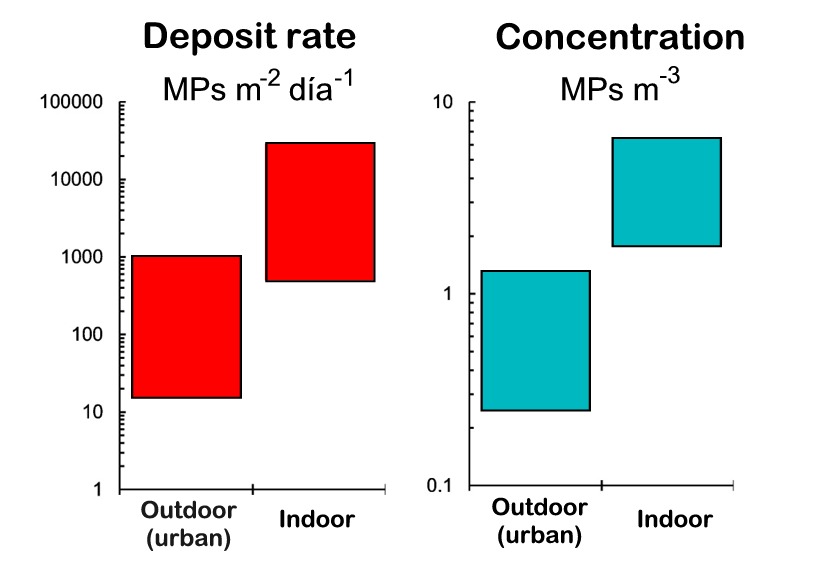Plastic in the air we breathe
In a previous post, it was explained that anthropogenic aerosol also contains microplastics, which, depending on their size, can remain suspended for a long time. As with other forms of plastic pollution, humans are responsible for releasing these particles into the environment, making areas with higher population densities the main sources of emissions. In the aforementioned post, some data on the sedimentation rates of plastics in various urban and natural areas were provided, and it was explained how they could be obtained using passive samplers (collectors that receive atmospheric deposition over a certain period). On the other hand, the concentration in terms of number of particles or mass per unit volume of air can be determined using active samplers, which are systems that pump a certain volume of air through a filtering medium. In either case, it is possible to quantify the presence (in number or mass) of plastics in environmental dust, although this determination is somewhat unusual.
Europeans spend up to 90% of their time indoors, in places such as private homes, workplaces, and various enclosed public spaces. Therefore, the impact of poor indoor air quality on health is potentially more significant than that of outdoor air. Unfortunately, it is also more challenging to study because indoor environments are much more complex and variable than outdoor ones. The interiors of buildings contain a diverse range of construction and decoration materials and may involve a much higher human presence than outdoor environments. Regarding plastic materials, indoor spaces can contain a wide variety of them in different applications and products. Some of the most common include polyvinyl chloride in windows and coatings, polyethylene in bags and containers, polypropylene in carpets, polystyrene in disposable kitchenware, polycarbonate or poly(methyl methacrylate) in appliances and electronic equipment, or polyurethane in cushion or mattress foams, among others. Of course, all of them contain a wide range of chemical additives, an important issue that will be addressed in detail in a later post.
The wide diversity of indoor environments and the variability of uses resulting from cultural differences make the available data on the presence of plastics indoors even more scattered than those obtained from outdoor samples. Additionally, as usual in studies about microplastics, there is significant diversity in the data reported in the scientific literature. There are studies with considerable methodological differences, especially in the range of sampled sizes, and even notable quality deficiencies, such as the absence of controls or the identification of plastics without the use of appropriate methods, such as infrared spectroscopy. Nevertheless, the general trend indicates a significantly higher concentration of plastics indoors than outdoors. This is clear in studies that compare, using the same methodology and equipment, the deposition rates or concentration in both types of environments, although such studies are scarce. The figure shows the variability observed in a selection of works (https://doi.org/10.1021/acs.est.0c00087, https://doi.org/10.1016/j.scitotenv.2023.168398, and https://doi.org/10.1016/j.scitotenv.2023.166923). Both the concentration and deposition rate, although highly variable, typically show values an order of magnitude higher indoors than outdoors.

Most studies agree that microplastics in the air, both in indoor and outdoor environments, are predominantly (up to 90%) in the form of fibers, which can be explained by their greater mobility. In general, the composition of these fibers corresponds to that of the most common textile products found indoors, including clothing. The predominant synthetic fibers are polyester, acrylic, polypropylene, and polyamides (such as nylon). These fibers are often accompanied by a considerable amount of cellulose fibers (non-plastic), which include a wide variety of artificial fibers (industrially processed cellulose) and semi-synthetic fibers (such as regenerated cellulose, which includes Rayon, Modal, or Tencel). For information on the classification of fibers based on their nature, please refer to a previous entry.
Of course, the inhalation of microplastics can have effects on human health, both due to their nature as anthropogenic particles and because these materials can contain numerous chemicals, some of which are potentially toxic. However, research in this field is still in a very early stage, as the effects would manifest in the long term, making it extremely difficult to obtain conclusive data. Anyway, some information has been obtained regarding the presence of microplastics in the human respiratory system. Some scientific articles have explored the presence of microplastics in bronchoalveolar lavage fluid and lung tissues. Regarding the latter, Amato-Lourenço et al. found microplastics in 13 out of 20 tissue samples from autopsies, while Jenner et al. found plastic in 11 out of 13 human lung tissue samples obtained from surgical procedures. In a study conducted on samples from lung explants (figure) analysed in our laboratory, we found 5 microplastic fibers (acrylic, polyester, and polypropylene) along with 87 cellulose fibers, representing a positive identification in 5 out of 24 subjects, a lower prevalence than reported in other studies.

It is important to highlight that the detection of microplastic fibers in human tissues is particularly challenging due to the need for digestion and the difficulty of obtaining clean samples in an environment heavily contaminated by fibers, such as a operating theatres. Although not impressive, the above results mentioned indicate the extent to which we are exposed to artificial materials. The question of whether this accumulation can cause alterations in respiratory function or other complications remains unanswered with the data currently available.